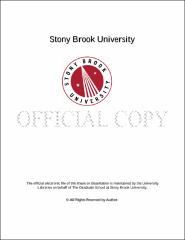| dc.identifier.uri | http://hdl.handle.net/11401/76926 | |
| dc.description.sponsorship | This work is sponsored by the Stony Brook University Graduate School in compliance with the requirements for completion of degree. | en_US |
| dc.format | Monograph | |
| dc.format.medium | Electronic Resource | en_US |
| dc.language.iso | en_US | |
| dc.publisher | The Graduate School, Stony Brook University: Stony Brook, NY. | |
| dc.type | Thesis | |
| dcterms.abstract | Vps13 is a large evolutionarily conserved protein of 3144 amino acids found in S. cerevisiae. Vps13 has been connected to disparate roles in the cell, including the retention of proteins in the trans golgi network, proper phospholipid composition and closure of the prospore membrane during sporulation, and a genetic interaction with the ERMES complex which brings the ER and mitochondria to close proximity. Mutations in VPS13A, a VPS13 ortholog found in humans, has been linked to a late onset neurodegenerative disease similar to Huntington's disease, called chorea acanthocytosis (ChAc). Previous sequencing of VPS13A in some ChAc patients uncovered missense mutations, which may provide insight into which role(s) of Vps13A are linked to the disease symptoms of ChAc. Of these missense mutations, we found three with clear cognate residues in Vps13 through Blastp alignment. This has allowed us to engineer these missense mutations into S. cerevisiae using a CRISPR/Cas9 method so that assays could be run to look potential defects. These assays include western blot analysis of carboxypeptidase Y sorting to check for TGN retention of Vps10, lethality in combination with mmm1Δ (a member of the ERMES complex), and the ability to form spores after being crossed to a strain containing vps13Δ and being plated on a media that induces sporulation. These assays have uncovered that two of the missense mutants, vps13-L66P and vps13-Y2702C, are lethal in combination with mmm1Δ . Amongst other functions, phospholipid exchange between the ER and mitochondria is an important process at the ER-mitochondrial junction, of which Mmm1 and the ERMES complex maintains. These results suggest that Vps13 and its ortholog Vps13A are potentially important for proper phospholipid exchange to the mitochondria through a yet unknown interaction at the ER-mitochondrial junction, and that this may be the cause of the disease symptoms in ChAc. | |
| dcterms.available | 2017-09-20T16:51:27Z | |
| dcterms.contributor | Neiman, Aaron | en_US |
| dcterms.contributor | Levy, Sasha | en_US |
| dcterms.creator | Policastro, Robert Anthony | |
| dcterms.dateAccepted | 2017-09-20T16:51:27Z | |
| dcterms.dateSubmitted | 2017-09-20T16:51:27Z | |
| dcterms.description | Department of Biochemistry and Cell Biology. | en_US |
| dcterms.extent | 51 pg. | en_US |
| dcterms.format | Monograph | |
| dcterms.format | Application/PDF | en_US |
| dcterms.identifier | http://hdl.handle.net/11401/76926 | |
| dcterms.issued | 2015-08-01 | |
| dcterms.language | en_US | |
| dcterms.provenance | Made available in DSpace on 2017-09-20T16:51:27Z (GMT). No. of bitstreams: 1
Policastro_grad.sunysb_0771M_12196.pdf: 1393292 bytes, checksum: eb45c877f677718ad3adb43bc637102f (MD5)
Previous issue date: 2014 | en |
| dcterms.publisher | The Graduate School, Stony Brook University: Stony Brook, NY. | |
| dcterms.subject | Chorea Acanthocytosis, CPY, ERMES, MMM1, Vacuolar Protein Sorting 13, VPS13 | |
| dcterms.subject | Biology | |
| dcterms.title | Characterization of Disease Related Missense Mutations in Vacuolar Sorting Protein 13 of Saccharomyces Cerevisiae | |
| dcterms.type | Thesis | |

